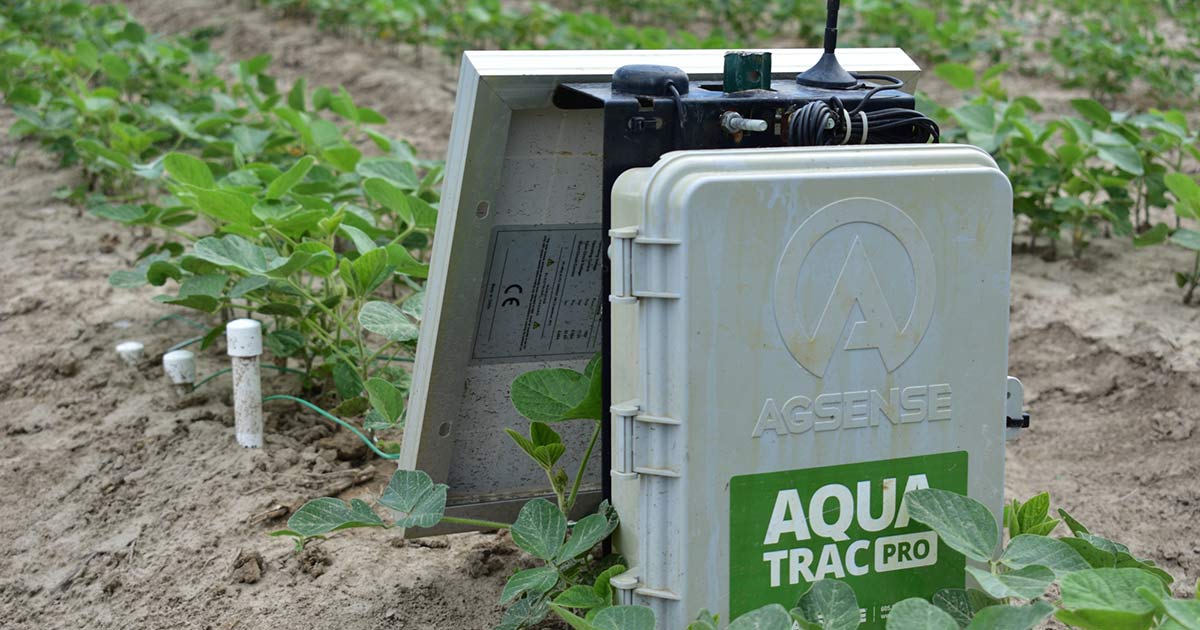Irrometer Watermark Series: Measurement Devices
This publication series provides information and recommendations pertaining to the Irrometer Watermark 200SS, a granular matrix sensor commonly used in Mississippi for scheduling irrigation. Future publications will discuss other types of soil moisture sensors. Users should choose tools that best fit their needs.
Introduction
A measurement device reads a Watermark sensor by determining the electrical resistance between the electrodes inside that sensor and then reporting the corresponding soil water tension. This publication describes three types of measurement devices and their advantages and disadvantages.
Handheld Meters
A handheld meter has a pair of alligator clips for attaching temporarily to the bare ends of a pair of sensor wires. After a sensor has been connected in this manner, its present reading can be displayed on the screen of the meter by pressing the buttons according to the manufacturer’s instructions.

For convenient access, the pair of original sensor wires can be spliced to a pair of extension wires that run along the crop row out to one end of the field. To avoid affecting the readings, the manufacturer recommends using waterproof direct-bury splice kits and underground feeder (UF) wire that is 18 AWG for lengths up to 1,000 feet, 16 AWG for lengths up to 2,000 feet, and 14 AWG for lengths up to 3,000 feet.
Among the three device types, the handheld meter demands the smallest initial investment and can read the largest number of sensors during the same season. Furthermore, no subscription costs and no additional in-field obstructions are involved. On the other hand, you have to check the sensor in the field, and you will see only its present reading at each visit. Unless you visit frequently enough to capture trends, scheduling irrigation and catching errors may be difficult.
Traditional Dataloggers
A traditional datalogger has several pairs of circuit terminals, and each pair can be joined to a pair of sensor wires throughout the season. The reading from each connected sensor is taken by the datalogger on a programmed schedule. These readings are stored and can be transferred via a cable from the datalogger to a computer. The datalogger can be located near its sensors, or it can be placed at an end of the field by adding extension wires (as described above).

A traditional datalogger requires a medium initial investment and no subscription costs. Besides financial considerations, criteria for selecting a particular datalogger model may include potential obstructions to field operations, data displays without a computer, system reliability, and maximum number of connected sensors.
Telemetry Units
A telemetry unit also connects with sensors by wires and reads those sensors on a programmed schedule. However, it can even transmit the readings wirelessly to an off-site computer server. You can view and download those readings primarily through web browsers or mobile apps.


In some systems, each telemetry unit transmits its data independently over a cellular network. In other systems, multiple nearby “nodes” communicate via radio with the same base station, which transmits the collected data over a cellular network.
The greatest strength of telemetry is that users can see past and present readings anytime and anywhere with internet access through a smartphone, tablet, or computer. In addition, some user interfaces have convenient features that can help with irrigation decision-making (e.g., automatic alerts) and trend visualization (e.g., interactive graphs). These capabilities are especially desirable for busy users who manage many fields and/or control irrigation systems remotely. To learn more about telemetry systems, visit https://www.ncaar.msstate.edu/outreach#showcase.
The tradeoffs to such benefits are the largest initial investment among the three device types, the need for service subscription payments, and the potential need for hardware (e.g., antenna, solar panel) above the canopy. Ultimately, the best measurement device is the one with characteristics that are most compatible with your operation.
For more information, please contact Extension Irrigation Specialist Drew Gholson at drew.gholson@msstate.edu or (662) 390-8505.
This publication is a contribution of the National Center for Alluvial Aquifer Research (NCAAR), the Mississippi State University Extension Service, and the Row-Crop Irrigation Science Extension and Research (RISER) initiative. NCAAR is supported by the Agricultural Research Service, United States Department of Agriculture (USDA), under Cooperative Agreement number 58-6001-7-001. RISER is supported jointly by Mississippi Soybean Promotion Board, Mississippi Corn Promotion Board, Mississippi Rice Promotion Board, Cotton Incorporated, Mississippi Peanut Promotion Board, and by USDA’s Natural Resources Conservation Service under Conservation Innovation Grant number NR203A750008G007.
The information given here is for educational purposes only. References to commercial products, trade names, or suppliers are made with the understanding that no endorsement is implied and that no discrimination against other products or suppliers is intended.
Publication 3537 (POD-09-24)
By Jacob Rix, former Extension/Research Associate; Himmy Lo, PhD, Assistant Extension/Research Professor, Delta Research and Extension Center; Drew Gholson, PhD, Assistant Professor and Coordinator, NCAAR, and Mark Henry, Extension Associate II, Delta Research and Extension Center.
The Mississippi State University Extension Service is working to ensure all web content is accessible to all users. If you need assistance accessing any of our content, please email the webteam or call 662-325-2262.





